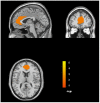The Interplay Between Risky Sexual Behaviors and Alcohol Dependence: Genome-Wide Association and Neuroimaging Support for LHPP as a Risk Gene
- PMID: 27531626
- PMCID: PMC5240175
- DOI: 10.1038/npp.2016.153
The Interplay Between Risky Sexual Behaviors and Alcohol Dependence: Genome-Wide Association and Neuroimaging Support for LHPP as a Risk Gene
Abstract
To identify genetic mechanisms involved in the interplay of risky sexual behaviors (RSBs) and alcohol dependence (AD), we conducted genome-wide gene-by-AD (GW-GxAD) analyses of RSB in 3924 alcohol-exposed and sexually experienced subjects. RSBs were defined as a score based on lifetime experiences of unprotected sex and multiple sexual partners. Diagnosis of lifetime AD was defined by DSM-IV criteria. To follow-up the genetic findings, functional magnetic resonance imaging analyses were conducted in an independent sample. A trans-population genome-wide significant signal was identified in LHPP (rs34997829; z=-5.573, p=2.51 × 10-8) in the GxAD analysis that also showed associations in the AD-stratified association analysis (AD z=-2.032 and non-AD z=4.903). The clinical relevance of the result was confirmed by the significant interaction between LHPP rs34997829 and AD with respect to self-reported sexually transmitted disease (STD; z=-2.809, p=4.97 × 10-3). The neuroimaging follow-up analysis of LHPP rs34997829 showed reduced power of the left superior frontal gyrus (t=-3.386, p=9.56 × 10-4) and increased power at the right amygdala (t=3.287, p=1.33 × 10-3) in the resting amplitude of low frequency fluctuations analysis; and reduced activation of the anterior cingulate region (t=-2.961, p=3.69 × 10-3) in the monetary incentive delay task. In conclusion, LHPP locus is associated to AD-RSB interaction; and with brain circuitries previously implicated in the inhibition of risky behavior and impulsiveness, emotional regulation, and impulse control/error monitoring. Thus, LHPP is a strong candidate to influence RSB and STD risk in the context of AD.
Figures



References
-
- American Psychiatric Association (1994) Diagnostic and Statistical Manual of Mental Disorders 4th Ed. American Psychiatric Press: Washington, DC, USA.
-
- Benjamini Y, Hochberg Y (1995). Controlling the false discovery rate: a practical and powerful approach to multiple testing. J R Stat Soc Ser B (Methodological) 57: 289–300.
Publication types
MeSH terms
Substances
Grants and funding
- RC2 DA028909/DA/NIDA NIH HHS/United States
- R01 DA012690/DA/NIDA NIH HHS/United States
- N01 HG065403/HG/NHGRI NIH HHS/United States
- R01 DA012849/DA/NIDA NIH HHS/United States
- UL1 TR001863/TR/NCATS NIH HHS/United States
- R01 AA016599/AA/NIAAA NIH HHS/United States
- R01 DA018432/DA/NIDA NIH HHS/United States
- R01 AA011330/AA/NIAAA NIH HHS/United States
- R01 AA017535/AA/NIAAA NIH HHS/United States
- RC1 AA019036/AA/NIAAA NIH HHS/United States
- P30 CA016359/CA/NCI NIH HHS/United States
- P50 AA012870/AA/NIAAA NIH HHS/United States
LinkOut - more resources
Full Text Sources
Other Literature Sources
Medical
Research Materials

